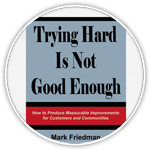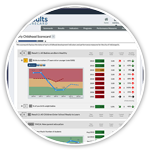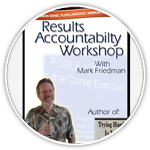What is Results-Based Accountability™?
Results-Based Accountability™ (RBA), also known as Outcomes-Based Accountability™ (OBA), is a disciplined way of thinking and taking action that communities can use to improve the lives of children, youth, families, adults and the community as a whole. RBA is also used by organizations to improve the performance of their programs or services. Developed by Mark Friedman and described in his book Trying Hard is Not Good Enough, RBA is being used throughout the United States, and in countries around the world, to produce measurable change in people’s lives. Click here for Translation Helpful Version of Basic RBA Ideas)
What’s different about RBA?
RBA uses a data-driven, decision-making process to help communities and organizations get beyond talking about problems to taking action to solve problems. It is a simple, common sense framework that everyone can understand. RBA starts with ends and works backward, towards means. The “end” or difference you are trying to make looks slightly different if you are working on a broad community level or are focusing on your specific program or organization.
Creating Community Impact with RBA
Community impact focuses on conditions of well-being for children, families and the community as a whole that a group of leaders is working collectively to improve. For example: “Residents with good jobs,” “Children ready for school,” or “A safe and clean neighborhood”. In RBA, these conditions of well-being are referred to as results or outcomes.
It is critical to identify powerful measures to determine the progress a community is making towards achieving community well-being. For communities, the measurements are known as community indicators and are usually collected by public agencies. A community wanting to have residents with good jobs may look at “turning the curve” on the unemployment rate.
Performance Accountability
Organizations and programs can only be held accountable for the customers they serve. RBA helps organizations identify the role they play in community-wide impact by identifying specific customers who benefit from the services the organization provides.
For programs and organizations, the performance measures focus on whether customers are better off as a result of your services. These performance measures also look at the quality and efficiency of these services. RBA asks three simple questions to get at the most important performance measures:
- How much did we do?
- How well did we do it?
- Is anyone better off?
In answering these questions, a job training program might measure:
- The number of trainees in its program
- The ability of its trainers to explain concepts
- The percentage of its trainees who obtain and keep a job.
Turn the Curve Thinking
Once you identify the most powerful measure(s) to improve, RBA provides a step-by-step process to get from ends to means. This process is called “Turn the Curve” thinking.
Why use RBA?
RBA improves the lives of children, families, and communities and the performance of programs because RBA:
- Gets from talk to action quickly;
- Is a simple, common sense process that everyone can understand;
- Helps groups to surface and challenge assumptions that can be barriers to innovation;
- Builds collaboration and consensus;
- Uses data and transparency to ensure accountability for both the well-being of people and the performance of programs.



